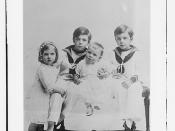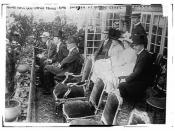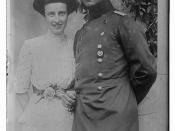A Visionary Heart
.
In the story, The Little Prince, the author, Antoinne De Saint-Exupery, is the narrator who is ostensibly recounting what occurred when his plane put down in the Sahara Desert, six years earlier, due to engine trouble. The story is written in simple, short sentences, as would be suitable to use to tell a tale to a small child, making it sound deceptively similar to a Peter-Pan-like a fairy tale. Briefly, a young prince from a distant planet comes upon the stranded author, and tells him of his experiences, in the form of parables, as he wandered among the planets seeking wisdom. One of the characters encountered by the Little Prince, the fox, reveals a "secret" to the prince, "It is only with the heart that one can see rightly; what is essential is invisible to the eye." After a week, which turns out to be the Little Prince's last week on the earth - having arrived exactly one year earlier on that spot, the little prince is bitten by a snake and "appears" to die, although his body disappears, in order to return to his planet.
The author, with his repaired plane, is left sad but enlightened and relates the story, complete with child-like drawings which are accompanied by explanations that encourage the reader to see the meaning in the drawings, more than the literal sketches. By illustration and by words, Saint-Exupery draws the reader into his vision and subtly exhorts the reader to lift his focus from that of an adult, critical reader into the realm of fantasy and enlightenment.
One of the first stories, told in chapters related by the narrator, is a story about an occurrence before he, the narrator, landed in the desert and encounters the Little Prince. The narrator, while ostensibly pointing out the limitations of his artistry, encourages the reader to see more than is on the page, that is Saint Exupery exhorts the reader to see the sketches less literally, to "see" the meaning in the drawings. In order to achieved this, Saint-Exupery describes the callous, concrete minded adults who have been unable to understand that what appeared to them to be a drawing of a hat was actually a boa constrictor which had eaten an elephant. This drawing becomes a litmus test. The Little Prince, of course, can immediately see the elephant within the boa constrictor, which signals to the reader that the Little Prince and the Narrator are of the same understanding of the significance of things, and that the Little Prince is definitely not one of the literal-minded "grown-ups." Throughout the story, the narrator reminds the reader that his drawings, particularly that of the boa constrictor, have always been misperceived by "grown-ups," and includes many other examples of adult literal-mindedness, such as preoccupation with numbers. Ultimately, if the reader would prefer to not be classed with one of the philistine "grown-ups," he or she needs to be able to "see" what the author describes as being contained, but not seen by the eye, in his sketches.
The Little Prince asks the narrator to draw a sheep for him and is rather specific about how the drawing should be - not too big, not too old. Finally the Prince is surprisingly very pleased with the narrator's irritable production of a picture of a box with three holes, within which is the sheep. The Prince is delighted with the narrator's artistic production, seems to treasure the drawing and there is something of an implied therapeutic value as the narrator's relationship with the Prince goes on, since he seems to elaborate less about how bad his drawings are. In fact towards the end when the narrator is producing a drawing of a muzzle for the sheep for the Prince, the Prince reassures the narrator concerning his drawings that, "Oh that will be all right, the children will understand." It is implied that the children, not the adults are ultimately the more knowledgeable. Also as his relationship with the Little Prince grows, the life on the Prince's planet, the possible use of the sheep in eating the baobabs (which need to be cut back regularly to protect the planet) and the safety of the rose grow as matters of interest and concern to the narrator. In short, the narrator comes to share his friends concerns as if they were his own.
Another parable related by narrator about the Little Prince's planetary encounters involves a fox. The fox asks the Little Prince to "tame" him and goes on to describe in a very sagacious way, that taming means " to establish ties." The fox tells the Little Prince, ". . . if you tame me, then we shall need each other. To me, you will be unique in all the world. To you, I shall be unique in all the world." The fox outlines how "taming" is done by ritualistically spending time together, coming to be reminded of the other person by seemingly unrelated visual fragments, and developing expectations of being together, wordlessly - ". . . words are the sources of misunderstanding." Finally, just before the Little Prince goes off the explain the rose bushes once he realizes that his one rose is more important to him because they have "tamed" each other, the fox offers the Little Prince a present of a secret. The secret is that, ". . . It is only with the heart that one can see rightly; what is essential is invisible to the eye," and that ". . you become responsible, forever, for what you have tamed."
Throughout the story, the Prince worries about his love object, a rose who has been left behind on his planet. The Prince has one rose on his planet and is in love with it. He describes his efforts to provide it protection from cold and predators, putting his rose under a glass bell jar for protection from drafts at night. Although the rose may have been responsible for the Prince's journey, throughout the book, while the Prince is telling of his travels and traveling with the narrator, the Prince worries about the welfare of his rose, his relationship to her, and the rose come to symbolize an abandoned, and longed-for love. "She cast her fragrance and her radiance over me. I ought never to have run away from her. . . I ought to have guessed all the affection that lay behind her poor little stratagems. Flowers are so inconsistent! I was too young to know how to love her." By the end, after the snake bites the Little Prince and he appears to "die" or is back to his planet unencumbered with his body, the narrator picks up the pieces of his friend's concerns and worries about whether or not the muzzle which he has drawn has a strap to secure it onto the sheep which presumably traveled with the Little Prince. It is significant of the growth of their friendship, that the narrator has also comes to worry about the rose: ". . . and for me, nothing in the universe can be the same if somewhere, we do not know where, a sheep that we never saw has - yes or not?-- eaten a rose. . . And no grown-up will ever understand that this is a matter of so much importance."
Towards the end of the book, "The Little Prince," Saint-Exupery has one of the characters encountered by the little prince, the fox, reveal a "secret" to the prince, "It is only with the heart that one can see rightly; what is essential is invisible to the eye." In order to understand the narrator's investment in the Little Prince's concern for his rose, the reader must suspend grown-up thinking. Indeed, throughout the entire book, in order to appreciate Saint-Exupery's fantasy, the reader is required to suspend critical, literal, left-brain, judgment about the implausibility of various occurrences in order to appreciate or "see" the impressive wisdom about life, love, friendship, responsibility, understanding, knowing the truth and death which is woven into the deceptively simple story.
BIBLIOGAPHY
Saint Exupery, Antoinne De. (1943) The Little Prince. New York,
Harcourt, Brace & Company
SHUT YOUR EYES AND SEE THE TRUTH;
YOU'LL GET THERE FASTER


